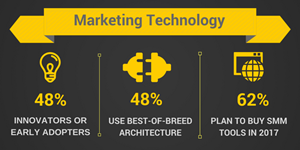Episerver Study, Sitecore Commerce, WCM, and More
Episerver: 92% of Consumers Don't Intend to Make a Purchase
On Monday, Episerver released the results of a survey they conducted of more than 1,000 consumers to give brands insight on where the pitfalls are in the commerce experience. The biggest finding, as Venus pointed out in her corresponding article, is that 92% of first-time visitors to a website do not intend to make a purchase, rather, they are more on a hunt for information.
brands insight on where the pitfalls are in the commerce experience. The biggest finding, as Venus pointed out in her corresponding article, is that 92% of first-time visitors to a website do not intend to make a purchase, rather, they are more on a hunt for information.
There is one thing you can sell them on though and that is an experience, not a product. This idea is nothing new but it’s substantial in the shift it is causing for online retailers. To that point, the same study suggests that 43% of respondents expect brands to know about their purchase histories, followed by personal interests with 25%, demographics with 20%, and billing information with 17%. This obvious demand for personalized experience is driving web content management vendors to adopt stronger, more tightly integrated personalization capabilities.
Outside of experience, shoppers can still shy away from completing a purchase and Venus points out a couple of reasons why. Content on the site, if its incomplete or inconsistent can be where you lose a customer, as it is a missed opportunity to offer the information they need. Retailers have to be careful and consistent with everything from product description to the content used to either describe or speak for the business itself.
Another pitfall, which cannot necessarily inhibit initial purchase but can cause a return, is the creation of a false expectation. If you think it doesn’t happen often enough to worry about, a study revealed that shoppers returned over $250 billion worth of items to U.S. retailers in 2015. That’s astounding when at least some of the problem can be addressed by the retailer with more thorough product descriptions, better zoom features, how-to content, guidelines and more.
Read the full article here.
Sitecore Connects Content Management with eCommerce
Over the weekend, Sitecore released a new version of its flagship project Sitecore Commerce, aimed at helping merchandisers and marketers deliver an end-to-end consumer shopping experience catered to each shopper, resulting in customer loyalty and leveraged business performance. On Tuesday, I had an interview with Nate Barad, Director of Product Strategy at Sitecore, to inquire about the solutions offered in Sitecore Commerce and what this new release means for the future of the market:
The biggest issue Sitecore addressed with the new release is the gap between the consumer and the brand. They see retailers still utilizing the old methods like promotions, discounts, flash sales etc and today’s more technically knowledgeable consumers are looking for an experience that’s far more tailored and personal. Nate emphasized that it’s not that they think brands aren’t aware of this need, but it’s that digital commerce is seen as just a channel when digital can enhance all channels.
Expanding on Nate’s interview, Venus goes into detail on the two major solutions offered in the release and singles out each innovative enhancement. In addition, they point out that Sitecore, being natively engineered for Azure Platform as a Service (PaaS) is its unique differentiator among vendors, as the platform is taking full advantage of Azure's capabilities which makes it easy to scale-up and out.
In his interview, Nate also discusses a very interesting and detailed approach Sitecore is taking with the common pain-point of abandoned carts, and explains how they are applying personalization and intelligence to understand how to minimize an issue previously under-solved in the space. If you’d like to hear more, watch the video and read the full article here.
What to Expect from the Web Content Management Market
Mid-week, Venus did a great overview article on what’s happening in the Web Content Management (WCM)  market and what to expect in 2017. Namely, she mentioned headless CMS, content in the cloud, eCommerce capabilities, personalization and artificial intelligence as the main things to be mindful of.
market and what to expect in 2017. Namely, she mentioned headless CMS, content in the cloud, eCommerce capabilities, personalization and artificial intelligence as the main things to be mindful of.
Headless CMS might arguably be the least understood of the bunch, but Petr Palas CEO of Kentico offered some great insight as to why the headless approach will make such an impact in 2017: “Yes, I expect that 2017 is the year when headless CMS concept will start going mainstream. There are currently two groups of vendors: traditional vendors who added an API element to their existing products and new coming vendors who built their CMS as headless from the ground up (often as a native cloud service). Now it's customers' turn to start adopting the headless approach and I believe we will see this happening much more often this year. Side by side with that, the new headless CMS products will continue to mature and become a viable alternative to those traditional.”
Artificial intelligence is a standout in the disruption conversation, which is funny since the concept has been around for decades however today, organizations are leveraging the power of AI to do all sorts of things ranging from natural language generation, to content analysis, to content optimization. MarketsandMarkets estimates that the AI market will grow from $420 million in 2014 to $5.05 billion by 2020, whereas Gartner predicts AI will become “the next battleground through 2020.” Therefore, enterprise software makers are in a cut-throat competition to bring predictive capabilities into their suites of products.
Read the full article here.
How To Create a White Paper that will Generate Leads- Part III
 As the third and final installment in her series, How To Create a White Paper that will Generate Leads, our contributor Leah Kinthaert gives us some helpful tips on how to share your content long term.
As the third and final installment in her series, How To Create a White Paper that will Generate Leads, our contributor Leah Kinthaert gives us some helpful tips on how to share your content long term.
Shareability was something she emphasized in the first two installments, as a key factor in the thought process of creating your content. Even bringing up a tidbit from a Kissmetrics blog post from 2014 citing “A piece of content should produce 20+ snippets that you can share on social media”. Imagine that, creating content with its evergreen nature in mind and building it off the very ways you will promote it in the future. Like a mini content strategy, within a bigger strategy.
But what if you didn’t start with such a case of content strategy inception? Repurposing content often hits a speedbump because it can be a direct opposition to the very framework of a piece. You want that flow, and for it all to link together into one big cohesive content digestion, so how do you effectively dissect it into these shareable pieces after the fact? My advice is to grab another pair of eyes, or a few pairs, and have them tell you what ideas are sparked in their head and run with those as an added value to the points made.
Leah also brings up a great discussion of where marketing automation fails us in terms of a digital imprint. We’ve all done it, we read a great publication but we don’t hit that handy little Facebook, Twitter or Linked In share icon. We copy the link, and paste it into a post we created ourselves and the author has no way of tracking all the eyeballs that will be on it once we share it within our communities and all the potential leads that will go unnurtured. You or your business might stick in their mind and they may circle back using a Google search but one day soon hopefully marketing software can catch up to the sharing far and wide.
Read the full article here.
Marketing Technology Adoption and Investment in 2017
2017 is on track to become the year that CMO marketing tech spend will exceed CIO technology spend and with that, we felt it important to put together a list of what we see as priorities for marketing technology adoption and investment in the coming year.
with that, we felt it important to put together a list of what we see as priorities for marketing technology adoption and investment in the coming year.
With all the marketing capabilities vendors are offering in their suites, it’s interesting to see which approach is more wide-spread. Almost half of marketers describe their marketing technology stacks as best-of-breed, with the majority of them calling their architecture “integrated” rather than “fragmented.” These findings also demonstrate that larger organizations tend to take advantage of more best-of-breed architecture compared to smaller companies. The reason why marketers embrace best-of-breed architecture is that they feel more comfortable adding more tools into their ecosystem as they believe, that way they get the most out of their martech tools.
Social media tools have frequently been purchased as of late, and it could be due to the needs of marketers changing as new uses for social media pop-up. The days of just spreading the word and reach are gone as more and more retailers see social media as a way to listen in on customer conversations online. Some brands have taken a tongue-in-cheek approach to jumping into these conversations to minimize any negative feedback spreading too far and some are seeing it as a way to bring customer service to a new level. A great example recently, was Elon Musk’s quick action when a consumer tweeted a complaint to him about other Tesla owners taking up charging spots once their vehicle was fully-charged. In less than a week, Tesla announced a new policy enacting an idle-fee to increase charger availability.
Marketers may be more the type to try new technologies and experiment with different innovations to see what works best for them, but Venus had some great advice for vendors in the space: “the vendors who make innovations that save marketers from their treadmill by lowering up-front and switching costs as well as providing high compatibility of their product are most likely to win their vote this year.”
Read the full article here.

Laura Myers
A digital business, marketing and social media enthusiast, Laura thrives on asking unique, insightful questions to ignite conversation. At an event or remotely, she enjoys any opportunity to connect with like-minded people in the industry.